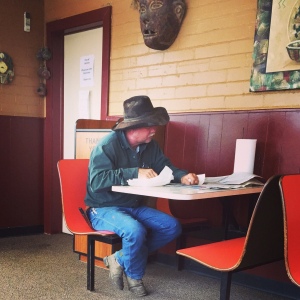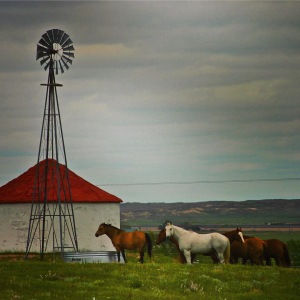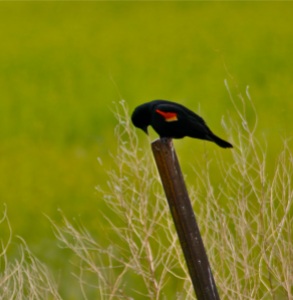The South Platte River is running big this year, and the mud in the fields around Sterling is boot-deep. Water is everywhere, overflowing levees near the pastures, corn and hayfields north of town. The swales along roadsides and railroad tracks are swamped, and backyards are squishy, so the ranchers are in the coffee shops, waiting it out.
“Too wet to get in the fields,” a ranchhand says over a Baja burger at the drive-in. “But we’ve had plenty of dry years lately … 2012, it got really bad,” he says, referring to the over-heated summer three years ago that baked all of Colorado. Demand for water soared, sapping supplies so fast that the gauges couldn’t keep up.
“But right now, it’s hard to believe you could run out of water,” he says, shaking his head at the giant puddles around his muddy truck outside.

Along the highway, the brawny, braided river has swamped giant cottonwoods, stripping the bark clean off and leaving 15-foot stumps. It may be too muddy for tractors, but the red-winged blackbirds are loving it, plucking fat worms out of the soggy ditches.
And across town, on the high ground of the local golf course, other water watchers, armed with Powerpoints and iPads, also talked about the surging South Platte. Tapping some of those high flows could help prevent the mid-century water shortage projected by state planners.

The population of the South Platte River Basin – Denver, Boulder, Fort Collins, Longmont and Greeley – may double in size in the next 35 years. A draft version of Colorado’s developing water plan says there just won’t be enough water for all those people, let alone farmers and ranchers out on the Plains, who are always worried the cities will siphon off the rivers before the water reaches the fields.
Channeling some of the water into reservoirs away from the main stream could be a way to boost supplies for the entire South Platte Basin, said Joe Frank, general manager of the Lower South Platte Water Conservancy District.
“We need to see a few more buckets and infrastructure. We’re in the heart of it here in Sterling,” Frank said, referring to the constant tussle over water between ranchers and farmers and the big Front Range cities of the South Platte Basin.
Working River
The 22,000-square-mile South Platte Basin starts up high at the Continental Divide in South Park and encompasses beloved tributary streams that are household names in Colorado: the Big Thompson, Cache la Poudre, and St. Vrain rivers; and Boulder, Clear, and Cherry creeks.

By the time the South Platte flows into Nebraska at Julesberg, it has earned its reputation as Colorado’s hardest working river, for supplying drinking water to millions and sustaining tens of thousands of acres of hay and corn fields and huge tracts of grazing. Most of what is grown is fed to cows at regional dairies and ranches.

The water plan, ordered by Gov. John Hickenlooper in 2013, is nearing completion, with a final draft due July 15. Filling the projected water shortage is a key goal.
The plan relies heavily on regional versions from nine major river basins included in the plan: the Arkansas, Colorado, Gunnison, Metro, North Platte, Rio Grande, South Platte, Southwest and the Yampa/White.
The new statewide plan will build on about 10 years worth of planning in those basins, each facing distinctive challenges. The Rio Grande Basin, for example, is concerned about erratic forecasts for stream flows that make allocating water more difficult, while the people in the Yampa Basin worry that water could be taken out of their beloved free-flowing river.
The huge projected gap in the South Platte Basin may be the biggest nut to crack, but it can be done. New water pipelines and reservoirs could help, but the state’s numbers show that a focus on massive water savings and modernization in cities and on farms can go a long way to ensuring the sustainable water future sought by the plan.
And if a proposal for a new project from one of the basins can do the nearly impossible, by helping cities, factories, farms and the environment, it could be targeted for state support, in the form of grants or legislation, as part of the final plan.

Historically, the South Platte Basin has looked outside its own boundaries, bringing in massive quantities of water from west of the Continental Divide, but this is a new era, according to water experts who helped shape the South Platte Basin’s regional plan.
That means finding water within the basin that hasn’t already been claimed by someone else, said consultant Matt Cook. Another option would be to enlarge existing reservoirs, like Empire, near Wiggins — but any of those projects would need some type of pumpback system to bring water where it’s needed, he said.
As part of the regional talks leading up to the statewide plan, farmers and cities have already had some preliminary discussions, said Jim Yahn, a farmer from the Sterling area who serves on the board of the local irrigation district.
Along with increasing supplies for cities, water from the South Platte River could also boost the fortunes of farmers around Sterling all the way to the Nebraska border, where there are tens of thousand of acres of fertile land that don’t have access to irrigation water, Yahn said.

“It all sounds good, but basically, we’re just trying to hold our own for agriculture,” Yahn said. “The real money would come from municipalities,” he added, acknowledging the huge cost of building new reservoirs and pipelines.
Yahn said there are also some technical challenges. When the river is high, there’s no way to use existing equipment to take more water, he said.
“Us ag people look at this all the time. The farmers need to be as one,” he said.
Featured image: Bob Berwyn. High flows in the South Platte River inundate farmlands near Sterling during the wet spring of 2015.


Part of the solution to our water problems is also attributable to the voters’ rejection in 2003 of Legislative Referendum A. Referendum A would have provided the funding mechanism for dam construction, repaid with water revenues and NOT taxes. Politicians, especially Democrats, lined up against Ref. A. Now, we’re paying the price. Store water in good years; release water in drought years.